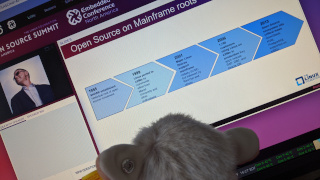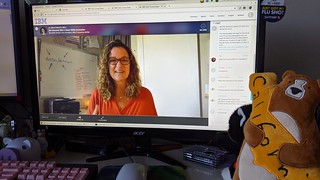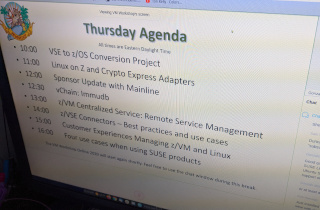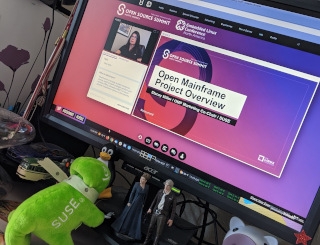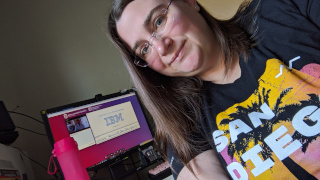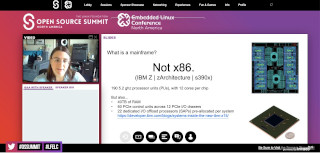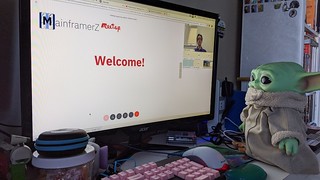It’s been over four months since I attended my last in-person conference, and last week marks the last conference I had on my schedule, but which was cancelled.
In these four months I’ve seriously attended probably a dozen online meetups, seriously participated in four virtual conferences, and gave four talks. As a whole, I am grateful that we can still connect and share knowledge with each other, but I’m really struggling with them, so here are some observations about virtual events.
It’s hard to stay focused on the event
Literally everything else in my life at home is conspiring to pull me away from participating in a virtual event. My family is just outside my home office door. Laundry is out there. I’ve really been meaning to re-organized my desk. Hey, a package has been delivered! And now it’s time for lunch, which doesn’t sync up with a break at the event because I’m in the wrong timezone.
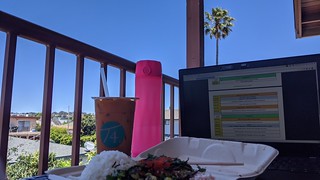
I got to choose my own lunch and had a nice view!
But the session I wanted to attend was still during lunch…
And my “regular” work is still happening. During in-person events, I chime in “at work” when I can, but generally my colleagues know I won’t be responding quickly because I’m engaged in the event and out talking with the community. This is much harder with a virtual event, I’m right there! And engagement is considerably less, so I do actually have the bandwidth to hop on a meeting or reply to a work email when the current session isn’t essential to my participation.
All the conferences I’ve participating in have also been in a different time zone. That means I’m starting work at 7AM, but it doesn’t mean I’m stopping at 3PM to make up for that, colleagues assume I’m still around to my regular end of day. The other day I started at 7AM for an event, but I needed a sync up with a colleague in China, and so my last meeting for the day began at 6PM. Even if I am more flexible about my schedule on any given day (not working for a straight 12 hours), it’s still a long day.
I don’t attend things that aren’t essential to my participation
I’ll back up to this comment I made a paragraph ago. When I’m at an event, I book meetings with people and take advantage of the hallway track, but I’m an introvert and sometimes I find myself with some time, so I’ll duck into a talk that I wouldn’t normally go to, but I have a passing interest in. Sometimes it ends up feeling like a waste of time, but more often I learn something interesting, make a connection (technical or personal), or simply am happy showing up as a friendly, supportive face in a talk being presented by someone I know. This hasn’t been happening with virtual events. I have simply been avoiding non-essential talks, and even when something interesting does pop up, my attention often waivers, or I end up replacing it with an impromptu work call or other work-related tasks.
The worst part about this is that I don’t feel the impact of this immediately. I’m just using my time efficiently! But after the event I feel like I didn’t get enough out of the event, and that it was sometimes an echo chamber. Even if I learn a lot about and contribute to my specific focus for the event, I missed out on so many other cool things happening in the tech world!
Travel
This is a double-edged sword. Traveling is tiring and takes me away from my family, and it’s so nice waking up in my own bed every morning! I absolutely appreciated that a conference was made virtual in the midst of my worst pregnancy morning sickness.
But I love traveling. With most trips I take at least a couple hours to soak in the local sights, pick up some gifts for the kiddo, send a post card. I get such joy out of wandering around the world, visiting places (new and old!) and visiting with people I can’t see at home. It makes the long, exhausting days worth it. I now find myself with a serious case of wanderlust.
Things that helped me
1. Shorter talks.
I can’t stress this enough. It’s incredibly hard to sit through a 60 minute talk at home. I suggest maxing out at 45 minutes, but 15-30 is better. And take advantage of the lightning talk format!
2. An integrated chat mechanism during talks.
I say integrated because I went to a conference where they had a Slack organization for the event, which certainly had it’s strengths. It allowed attendees to congregate prior to the event, lots of channels were created for fun and interesting topics, and it wasn’t all centered around the talks, which I appreciated, since conferences are more than that! But as a participant, there was a much warmer feel to the sessions when I could see attendees chatting away and answering each other’s questions during the talk (often directed at the speaker, but quality answers from the audience are great, too!). When I was giving a talk, having a mechanism for attendees to send questions to me that came up in a section of my screen also reminded me that people were there and actually paying attention enough to ask questions.
3. Live attendee counts.
Virtual events are incredibly isolating, both as an attendee and a speaker. I can’t say how valuable it was knowing I wasn’t actually alone, and as a speaker that I wasn’t just speaking into the void.
4. Single track.
This is not going to be possible for a lot of events, but I the ones I’ve participated in that have been single-track gave me a much stronger closeness with the fellow attendees. We were all participating in the same sessions throughout the event, speakers could reference previous talks, and you gained some familiarity with the moderators and active participants in the chat.
5. Visible themes.
You don’t need to have all of your speakers dressed up in costumes (though that does make things more interesting!), but even small things that make you feel like all the presenters are at the same event helps. That can be a custom slide deck theme that all presenters use, or a little toy or printed sign the speakers place on their desk during their talk. Just a little something that shows continuity instead of staring into an endless parade of home offices, living rooms, and kitchens.
As an attendee, I’ve also come up with a “visible theme” myself that has helped. I aggressively take photos at events to share on social media, and I wanted that continuity as I attended virtual events, but who wants endless pictures of my monitor? Well, there was no avoiding taking pictures of my monitor, but I kept myself entertained by having an ever-changing cast of stuffed animals joining me next to my monitor. Sometimes they’d be topical, with a penguin for an interview with Linus Torvalds and the SUSE chameleon for talks by SUSE employees, but just as often they were random. The key was that I got up between sessions to raid my stash of toys and brought a new one to each talk, also trying to mix up the camera angle as much as possible.
At the one event, I also dressed for the occasion! Each day I wore a different t-shirt from a past iteration of the event and tweeted a photo just before the keynotes.
6. Clear schedules.
This is one that came up for a couple the more corporate events. The headline sessions were promoted and highlighted extensively on the site, but there was no grid view of all talks, and it was a struggle to find some of the more niche topics.
This was frustrating as a participant and a speaker. A topic I spoke on was a bit niche (mainframes often are!), so it was nearly impossible to find on the schedule, and there were a few talks I knew were somewhere on the schedule, but I didn’t manage to find. Ultimately, I skipped all but a couple keynotes for one of these conferences, and only spoke at my own talks for the other. These two didn’t make the cut for my list of conferences I “seriously participated in” as mentioned at the beginning of the blog post, because the lack of a clear schedule just made it to hard for the event to be valuable to me.
And please, include the time zone on your schedule!
7. Encouraging social media presence.
Again, it’s hard to be drawn in and “feel” an event without fun pictures, but you can still lead the way in encouraging social media participation. As the event itself, keep tweeting! Retweet posts from attendees! Are you an open source project? Take some screenshots and tweet about speakers on your project!
Not all bad!
There are definitely upsides to virtual events. Many of them are free, or significantly cheaper than their in-person counterparts, allowing more people to overcome the financial barriers in place for attending. You have the opportunity to attract a more international audience because people aren’t required to travel.
Giving the opportunity to share knowledge with so many more people at the actual event, instead of just videos posted afterwards, is not something to be overlooked. I hope that our experience from this year can continue the trend of some conferences being virtual and so we have the tools and expertise to improve these experiences for the future. Already I’m seeing changes in platform technology, and with every virtual event I attend I get a new experience and new ideas about how to bring us all together.


